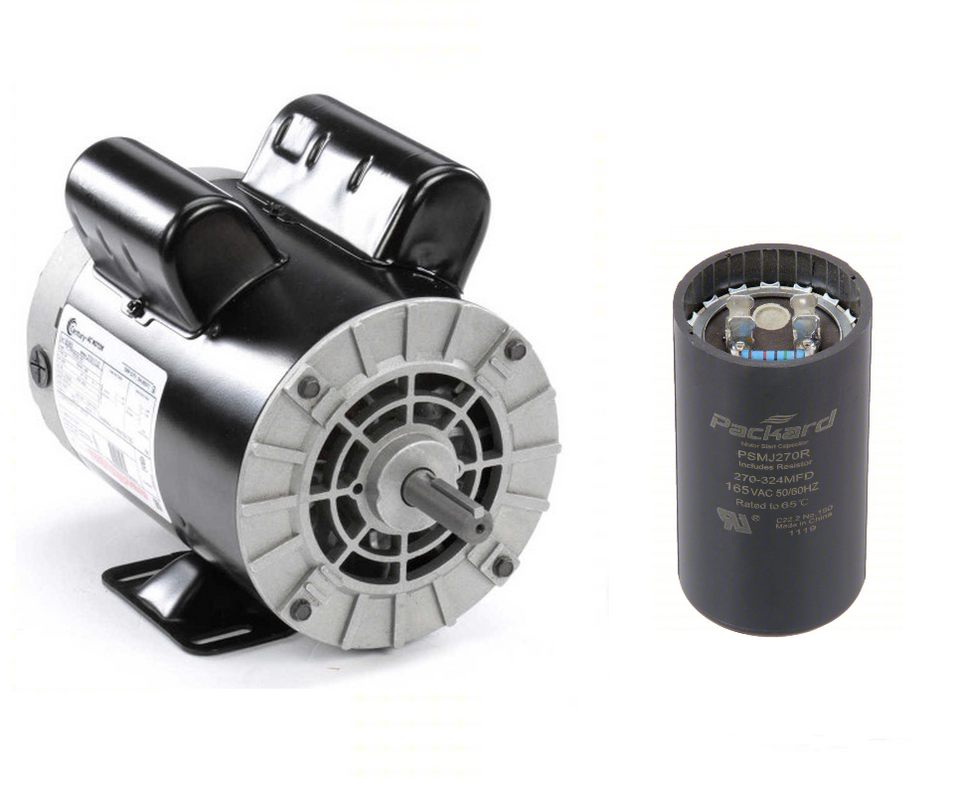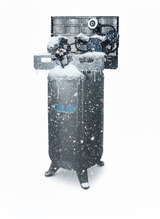Air Compressor Motor Troubleshooting: Diagnosing Hard Start Issues
At Master Tool Repair, we understand the critical role your motor plays. This guide will help you diagnose common reasons why your air compressor motor might be struggling to start, empowering you to identify the problem and find the right solution.
Safety First! Crucial Steps Before Troubleshooting
Before you begin any inspection or repair on your air compressor's motor or electrical components, always prioritize safety:
- Disconnect Power: Unplug the compressor from its power source or turn off the circuit breaker.
- Bleed Air Pressure: Fully drain all air from the tank by opening the drain valve until the pressure gauge reads zero.
- Allow to Cool: Ensure the compressor pump and motor have completely cooled down if they've been recently operated.
- Capacitor Discharge: If you suspect a capacitor issue, never touch the terminals without safely discharging it first. If you're unsure how to do this, or uncomfortable with electrical work, consult a qualified electrician or repair shop.
Common Culprits Behind Hard Start Issues:
Let's explore the typical reasons your air compressor motor might be struggling to start:
1. The Check Valve Problem
- Symptoms: Your motor runs fine and powers the compressor pump until it reaches cut-out pressure and shuts off. However, when the compressor attempts to restart and recharge the tank, the motor struggles, hums, stalls, and often trips the circuit breaker.
- Why it happens: A defective check valve fails to seal properly when the compressor shuts off. This allows compressed air from the tank to "back-feed" into the pump head. When the motor tries to restart, it's pushing against a tank full of air and pressurized air in the cylinder/head, which is an impossible load for it to overcome.
- Solution: This is a strong indication of a defective check valve. You'll need to perform a check valve test (refer to our dedicated check valve troubleshooting guide on the blog) and likely replace it if faulty.
2. Capacitor Problems
- Symptoms: Your motor hums loudly but doesn't spin, or it starts very slowly and then stalls or trips the breaker. You might also notice a burning smell.
- Why it happens: Air compressor motors often use one or two capacitors (start capacitor, run capacitor, or both) to provide an initial jolt of power to get the motor spinning, or to maintain its run cycle. If these fail, the motor lacks the necessary electrical boost.
- Diagnosis & Solution:
- Visual Inspection: Carefully remove the capacitor covers (often the "humps" on the back or side of the motor). Look for signs of overheating, swelling, bulging, or leaking fluid – these are clear indicators of failure.
- Testing (Professional Recommended): While specialized capacitor testers exist, handling capacitors requires electrical knowledge due to potential stored charges. If you're not experienced, it's best to take the motor to a local repair shop or have an electrician diagnose it.
3. Starter Switch (Centrifugal Switch) Issues
- Symptoms: Your motor attempts to start, begins to spin, but quickly slows down, stalls, and then kicks the circuit breaker.
- Why it happens: Inside some motors, a centrifugal (or starter) switch briefly engages the start capacitor to give the motor a boost. Once the motor reaches a certain speed, small weights on springs swing out, opening electrical contact points and disengaging the start capacitor. If these contact points are corroded or stuck, the starter capacitor may not properly engage or disengage, hindering the motor's ability to build or maintain speed.
- Diagnosis & Solution:
- Inspection (Advanced DIY/Professional): This often requires carefully opening the motor end housing (usually held by long bolts). Look for a small disc with a copper (or similar material) "stick" leading to electrical contact points. These points should be clean and "closed" when the motor is off.
- Cleaning: Sometimes, gently cleaning corrosion off the contact points with a fine emery file can resolve the issue.
- Replacement: If points are damaged or the mechanism is faulty, the switch or associated motor parts may need replacement.
- Caution: Working inside a motor involves electrical components and delicate parts. If you're not comfortable, seek professional assistance.
4. Belt Problems
- Symptoms: Your motor seems to spin fine, but the compressor pump isn't building pressure efficiently, or the motor sounds like it's slowing down (but isn't actually) and labors, eventually tripping the breaker under load. There might be a burning smell from rubber. Compressors typically do NOT squeal when belts slip – it's more of a grinding or labored sound.
- Why it happens: Old, hardened, or loose belts lose their grip on the pulleys, causing slippage. This means the motor is turning, but the pump isn't receiving full power, leading to low RPM on the pump.
- Solution:
- Inspect & Replace: Inspect your belt(s) for cracks, wear, or hardening. 90% of the time, low RPM from belt issues is caused by old, hard belts. Change them.
- Proper Tension: After replacing, tension the belt(s) correctly. There should be about 1/2" (half-inch) of deflection when pressed with your thumb at a point halfway between the pulleys.
- Caution: Do not over-tighten the belt, as this can lead to broken crankshafts or burnt bearings.
5. Motor Horsepower (HP) & Electrical Supply Issues
- Symptoms: The motor consistently bogs down under load, trips the breaker, or simply feels underpowered for the pump it's supposed to drive.
- Why it happens:
- Undersized Motor: The motor's horsepower is simply not adequate for the size and demands of the compressor pump.
- Incorrect Voltage/Wiring: A 230V motor mistakenly wired for 120V (or vice-versa), or an improper voltage supply from your panel.
- Power Starvation: Low voltage at the outlet, a weak ground, undersized wiring from your electrical panel, or a too-long wire run.
- Poor Connections/Burnt Contacts: Loose or corroded connections on the motor, pressure switch, or starter can restrict power flow.
- Diagnosis & Solution:
- Verify Motor & Pump Match: Ensure the motor's HP and RPM are compatible with your compressor pump's requirements.
- Check Voltage: Verify the voltage supply at the motor terminals matches the motor's rating.
- Professional Electrical Diagnosis: For most electrical supply issues (low voltage, poor connections, etc.) and amp draw testing (using an amp probe to check if the motor is "over-amping"), it's highly recommended to consult a qualified electrician. They can safely diagnose complex electrical problems.
A motor that struggles to start is a clear sign your air compressor needs attention. By systematically troubleshooting the common issues outlined above, you can often identify the problem and restore your compressor's power.
Whether you need a new starter switch, a fresh belt, a high-quality check valve, or advice on upgrading your motor, Master Tool Repair is your trusted partner for all air compressor parts and solutions. We're here to help you get your equipment running smoothly again!
Recent Posts
-
Cold-Start Proofing Your Air Compressor: A Practical Guide to Oils, Filtration, and Controls for Winter Reliability
Cold weather exposes weak links in any compressed air system. Thick oil, sluggish controls, and mois …Dec 23, 2025 -
Troubleshooting Your Air Compressor When Your Motor Just Hums, Clicks, or Won't Start
There’s no sound more frustrating in a workshop than the failed attempt of an air compressor to star …Dec 17, 2025 -
Air Compressor Pressure Switches: Beyond the Basics of Adjustment
The Brain of the Beast: Understanding Your Pressure Switch The pressure switch is the unsung hero of …Dec 10, 2025




